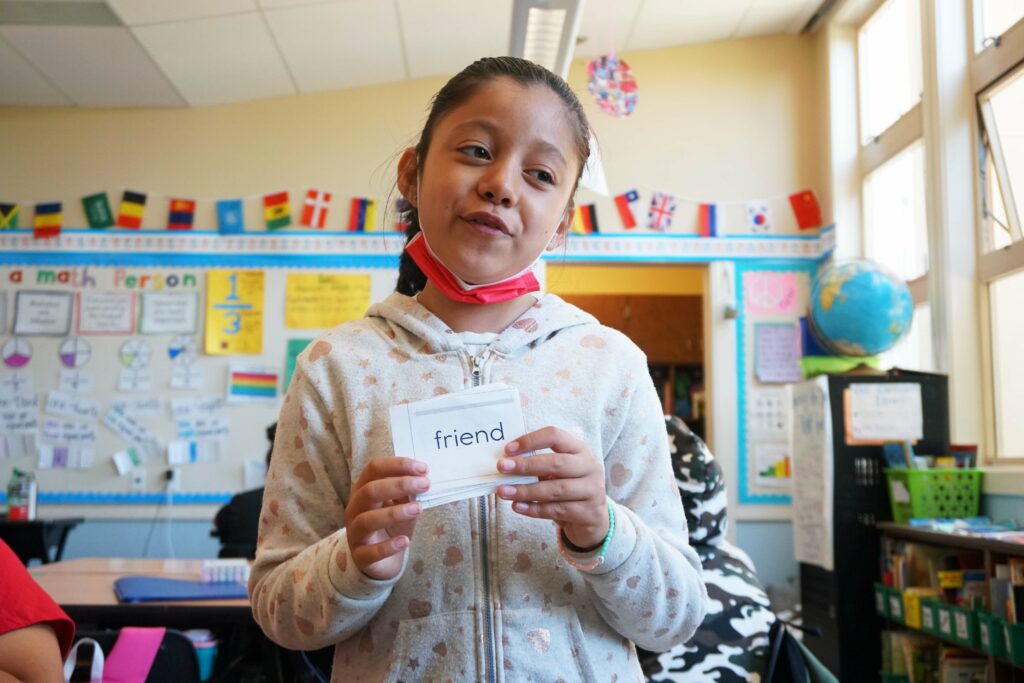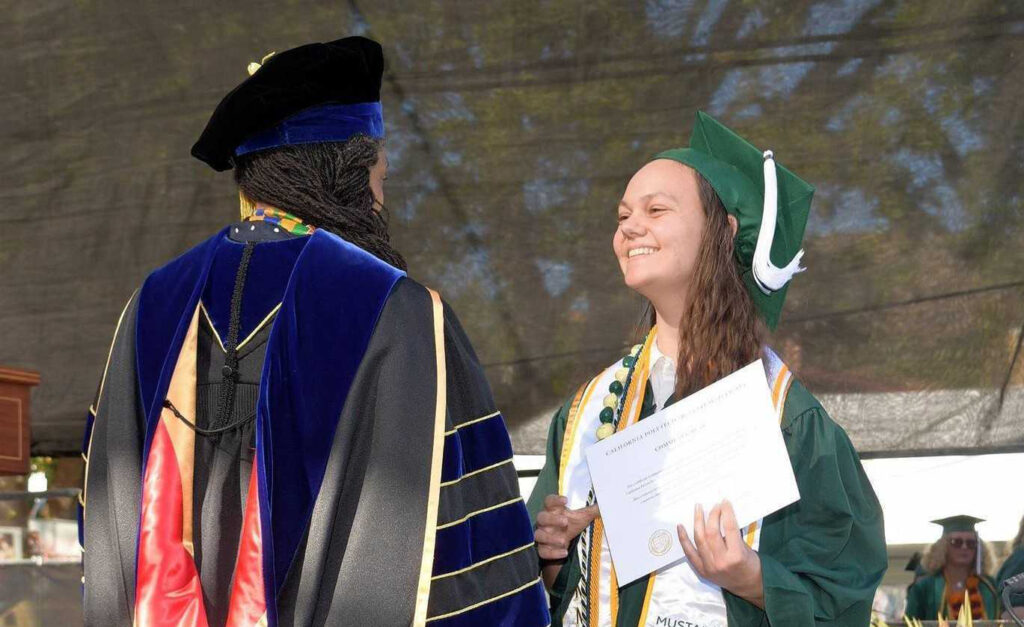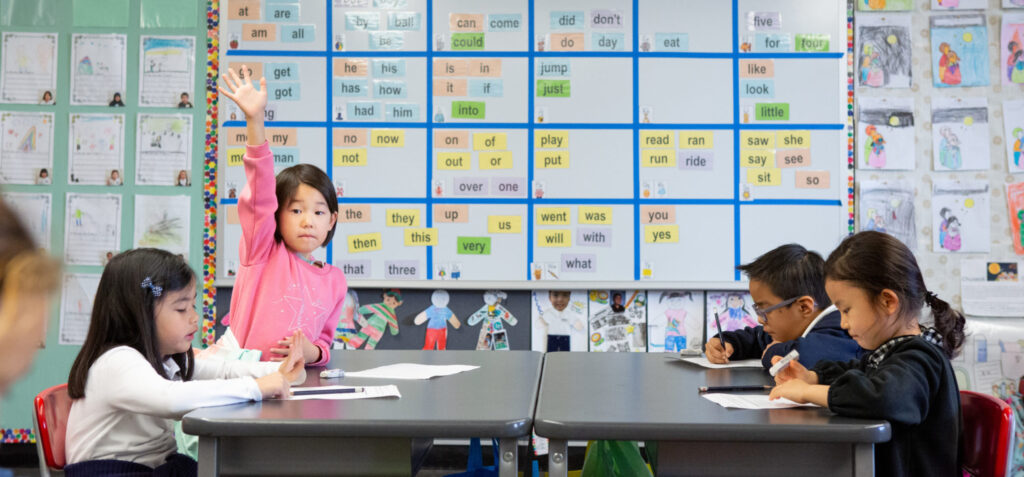
A kindergarten student raises her hand in a dual-language immersion class.
Credit: Allison Shelley for American Education
My post doc after finishing my degree in 1984 was teaching first grade at the bilingual elementary where I had done dissertation research. As I headed out into the real world, a widely admired literacy professor advised, “Just make sure everything you have them read is deeply meaningful.” Sounded about right.
It took me nearly three years to realize how not right that was.
The first hint
I had seen in my research that kindergarten classrooms at the school were almost devoid of children’s direct experiences with print. It was all about “readiness” and “developmental appropriateness.”
So, one of my teacher colleagues and I did a small study using photocopied booklets (“libritos”) we wrote and illustrated for kindergartners in Spanish reading. We thought using engaging little booklets, with opportunities for kids to memorize, “pretend-read,” enjoy, and talk about the little books would help “prepare the ground” for learning to read.
The study went well, and there was great enthusiasm. But we found no differences on any measure of pre-reading or emergent reading between the kindergartners using the libritos and the overall performance of the four comparison classrooms.
A dive into the data, however, showed that not all comparison classrooms were alike.
While scores were low in two of them, the other two, taught by teachers new to the school, had scores that were off our charts. Many of those kindergartners were actually … reading.
I had to visit. What I saw was shocking: classes like well-oiled machines. Kids in small groups rotating efficiently as a bell signaled the end of each 15-minute block.
One group with the teacher doing directed fast-paced instruction on letters, sounds and combining them to read syllables, then words (for the Spanish readers) or cvc words (like “dad” or “pal,” for the English readers), then short phrases or sentences.
Another group on the rug playing literacy games or looking at books. Another engaged in an aide-directed activity, such as dictation. Another working independently, copying then illustrating words or phrases posted on an easel.
This did not fit the child-centered conception of kindergarten I brought with me from graduate school. But children were productively engaged. And those darned study results.
We re-ran the study the following year, using new and better stories and illustrations (upgraded to “Libros”) and involving only Libros classrooms and the two classrooms that did so well the year before. We basically got the same results. In fact, testers commented that children from the two teachers I’d visited were really “into it,” eager to show what they could do with print. Children in the Libros classrooms were more wary.
The second hint
I was teaching first grade while doing this study, and students who had been in these teachers’ classes came into my class the following year. These kids could read. Their reading was syllable by syllable and robotic—e.g., “Pe. pe. da. la. pe. lo. ta.” (“Pepe gives the ball”) but I was able to fix this by using a prompt I’d learned when observing Reading Recovery in New Zealand: “Read it like you’re talking” (“Léelo como si estuvieras hablando”), pointing out the words meant something, and they should read that way.
(I gave the feedback about robotic reading to the two kindergarten teachers. The following year, their kids came in reading like champs.)
These kids had a firm grip on the “alphabetic principle” and decoding. Moving them quickly to more challenging and interesting reading material was pure joy. Students from other kindergarten classrooms … not so much.
The third hint
I had a small, diverse group learning to read in English. They had very little in the way of literacy foundations, so it was up to me to lay them. Still working on the “make sure everything they read is meaningful” premise, I struggled. So did they.
One of my English readers was a diminutive boy who had trouble “getting it.” He tried and was conscientious, but letters and words remained mysteries. One day he was not in class. His family had moved to a nearby district. I was sorry to see him go; he was bright and inquisitive. But I admit (embarrassedly) to being relieved.
A month later, he reappeared. “Ohhh,” I thought, but put on a happy face and welcomed him. “Hey, how you doing? Where you been?” I asked. He told me he had gone to another school, but his family had decided to move back. He didn’t seem to mind. But neither was he particularly enthused.
When reading time came around for the English reading group, he got the reading book he’d been using, opened it, and started reading. I did a double take. “Where’d you learn to read?” I asked.
“My teacher taught me at the other school,” he answered. My teacher taught me at the other school. Daggers to the heart.
“So, what did you do at your other school?” I asked, trying to be as nonchalant as he. “I practiced my spelling words.” “And what else?” I asked. “And learned my letters and read in my book.” He was reading. And better than anyone else in the group.
Fourth — and nailed it
In the last two years of my brief first-grade teaching career, I got a post-doctoral fellowship to pursue my research while continuing to teach half-time. This required finding another teacher to share a classroom.
Our first meeting was not auspicious. She was dedicated to phonics first, while I was still — albeit now a bit wobbly — in the “make it meaningful” camp.
She took Monday, Tuesday and alternating Wednesdays; I had the other Wednesday, then finished the week.
She would handle letters, sounds, phonics, and decoding; I would focus on comprehension, generally trying to make the best of what I was sure would be meager literacy gruel she served up.
Despite our mutual suspicions, we made it work.
I soon saw her foundational focus early in the week helped kids get the foothold needed to read accurately and with confidence. She likewise saw when she returned on Mondays that our students were reading and writing in ways qualitatively different from what she had seen when she taught her own classroom in prior years. Our kids were moving ahead at a fast, but unforced, pace.
Many landed in that happy place I later came to know as “self-teaching”, what teachers sometimes refer to as “the light goes on.” Children suddenly understand the rules of the reading road, and they progress rapidly as new letters, sounds and spelling patterns become absorbed into a growing understanding of how to read. By the end of that year and the next one with our second crop of first graders, we had our kids get further than either of us had ever accomplished individually. I told this story to someone a few years back who said we had created a demonstration site for Scarborough’s rope, a reading-education metaphor that visually depicts the interconnected strands needed for skilled reading.
Whatever it was, we had each learned some lessons.
•••
Claude Goldenberg is Nomellini & Olivier Professor of Education, emeritus, in the Graduate School of Education at Stanford University and a former first grade and junior high teacher.
This commentary is adapted from an essay originally published on his Substack, We must end the reading wars … now.
The opinions expressed in this commentary represent those of the author. EdSource welcomes commentaries representing diverse points of view. If you would like to submit a commentary, please review our guidelines and contact us.








